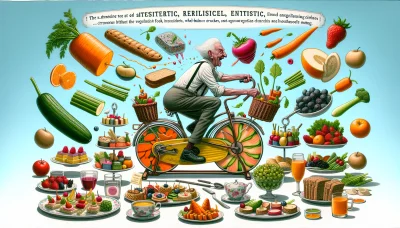Person cooking Quiz
Test Your Knowledge
Question of
Essential Cooking Techniques for Healthy Eating
Mastering the Basics
Developing fundamental cooking skills is the first step towards creating nutritious and delicious meals. These core techniques form the foundation of a healthy eating lifestyle. From chopping vegetables to mastering the perfect simmer, these basics are crucial in any kitchen.
Understanding the relationship between food and heat allows you to bring out the natural flavors while preserving nutrients. Whether you're steaming broccoli or searing chicken, knowing how heat affects food will help you avoid overcooking and nutrient loss.
Knife Skills and Safety
Efficient knife skills are paramount for any home chef. Proper cutting techniques not only save time but also ensure uniform cooking. Keeping knives sharp reduces the risk of accidents, making your kitchen a safer place.
Knowing how to handle a knife with confidence is essential for speedy meal prep. Practice makes perfect, so start with basic cuts and work your way up to more complex techniques like chiffonade or julienne.
Understanding Cooking Methods
Different cooking methods can either enhance or diminish the nutritional value of ingredients. Grilling, steaming, and poaching are excellent ways to retain vitamins and minerals. Meanwhile, deep-frying or excessive boiling can lead to nutrient loss.
Selecting the right cooking method also impacts the taste and texture of your food. Experiment with various techniques to discover how they affect different ingredients, enhancing your culinary repertoire.
Seasoning and Flavor Balancing
The art of seasoning goes beyond just salt and pepper. It's about creating harmony on your plate. Herbs, spices, acids, and fats can all contribute to a well-rounded flavor profile without adding excessive calories.
- Taste as you go: Adjust seasonings incrementally to avoid overpowering dishes.
- Fresh is best: Whenever possible, use fresh herbs and grind spices to ensure maximum flavor.
- Balanced flavors: Aim for a balance of salty, sweet, sour, bitter, and umami in each dish.
- Healthy swaps: Substitute heavy creams with yogurt or use citrus zest to add freshness without excess fat or sugar.
Advanced Cooking Strategies
Moving beyond basic cooking techniques opens up a world of culinary possibilities. Advanced methods like sous vide and fermentation not only enhance flavor but can also improve nutritional content. Embracing these strategies can transform your meals into gourmet health experiences.
Becoming proficient in advanced cooking strategies requires patience and practice but yields incredible rewards in both taste and health benefits. Dive into these sophisticated techniques to elevate your home cooking to restaurant-quality levels.
Sous Vide for Precise Cooking
Sous vide is a game-changer for achieving precise doneness without overcooking. This technique involves vacuum-sealing food in a bag and cooking it in a water bath at a controlled temperature. The result? Perfectly cooked meats, vegetables, and more every time.
The beauty of sous vide is its ability to maintain nutrient density by preventing high-temperature damage. It's an unparalleled method for ensuring consistent quality while locking in flavors that would otherwise be lost during traditional cooking methods.
Fermentation for Gut Health
Fermentation isn't just about crafting tangy sauerkraut or spicy kimchi; it's a process that enriches foods with beneficial probiotics essential for gut health. Incorporating fermented foods into your diet can aid digestion and boost your immune system.
The process of fermentation may seem intimidating at first glance but it's quite accessible with some basic knowledge. Start with simple projects like homemade yogurt or kombucha before venturing into more complex fermentations like miso or tempeh.
Batch Cooking for Meal Prep
Batch cooking is a strategic approach that saves time while ensuring you have healthy meals at hand throughout the week. Preparing large quantities of staple items like grains, proteins, and vegetables can streamline mealtime decisions.
This method not only aids in maintaining a healthy diet but also reduces food waste by utilizing ingredients efficiently. By investing time upfront in batch cooking, you gain back precious moments during busy weekdays without sacrificing nutrition or flavor.
Choosing the Right Ingredients for Your Diet
Shopping for Diet-Specific Foods
Embarking on a new diet can be an exhilarating journey towards health and wellness. When shopping for diet-specific foods, it's crucial to have a clear plan. Start by crafting a detailed grocery list that aligns with your dietary goals. This not only keeps you on track but also helps avoid temptation. Supermarkets are treasure troves of variety, offering an array of products catering to different dietsfrom keto to vegan, there's something for everyone!
Navigating the aisles becomes a breeze when you're well-informed. Consider downloading apps designed to simplify finding diet-compatible foods. They can scan barcodes and instantly reveal whether an item fits your dietary needs. Remember, strategic shopping is keystick to the perimeter of the store where fresh produce, meats, and dairy alternatives are typically located, and you'll be sure to fill your cart with nutrient-dense choices.
Reading Labels for Dietary Restrictions
When it comes to adhering to dietary restrictions, reading labels is non-negotiable. They are a window into the contents of your food, providing essential information about ingredients and nutritional value. Look out for hidden sugars, unhealthy fats, and additives that could derail your diet plans. For those with allergies or intolerances, checking labels is a critical step in avoiding adverse reactions.
It's not just about what's inside; serving sizes on nutritional labels can be deceiving. A product might seem healthy at first glance until you realize the listed nutrients are based on tiny portions. Always do the math to ensure your intake aligns with your dietary goals. And don't overlook the fine print! Sometimes the most crucial details about allergens and cross-contamination risks are tucked away at the bottom.
Organic vs. Non-Organic Choices
The debate between organic and non-organic foods is ever-present in the health-conscious community. Organic products promise lower levels of pesticides and GMOs, which appeals to many consumers. However, they often come with a higher price tag. It's essential to weigh the benefits against your budget constraints.
If going fully organic isn't feasible, familiarize yourself with The Environmental Working Group's "Dirty Dozen" lista guide highlighting produce that's most likely to contain pesticide residues. Prioritize purchasing these items organic when possible. Conversely, their "Clean Fifteen" list identifies produce that's generally safe to buy non-organic due to minimal pesticide contamination.
Locally Sourced Ingredients Benefits
Incorporating locally sourced ingredients into your diet isn't just a culinary trendit's a sustainable choice that supports local economies and reduces environmental impact due to lower transportation emissions. These ingredients often arrive at your table fresher and more nutrient-rich than their long-haul counterparts.
- *Enumerative Lists: Used for itemizing elements, events, or tasks, often in a specific order. Ordered Lists: Sequence matters (e.g., procedural steps, rankings). Unordered Lists: Sequence does not matter (e.g., grocery lists, to-do lists). *Descriptive Lists: Each item is accompanied by additional details or a description. Useful for catalogs, menus, or directories. *Checklists: Designed for tracking completion or presence of items or tasks. Common in project management, inspections, and daily routines. *Multilevel Lists: Nested lists with items having sub-items. Useful for outlining complex information, hierarchical data, or detailed plans. *Matrix Lists: Information presented in a two-dimensional grid or table format, where lists are organized both vertically and horizontally. *Priority Lists: Items are organized based on their importance or urgency. Common in project management and personal productivity systems. *Comparative Lists: Used for juxtaposing two or more items, options, or ideas often to highlight differences or similarities.
Meal Planning for Specific Diets
Structuring a Balanced Vegetarian Diet
A balanced vegetarian diet can provide numerous health benefits, but it requires careful planning to ensure all nutritional needs are met. It's crucial to include a variety of foods that supply sufficient protein, vitamins, and minerals. Balance and diversity in your food choices are key components to thriving on a vegetarian diet.
To avoid common pitfalls, vegetarians should be mindful of not just what they exclude but also what they include in their diets. It's not enough to simply cut out meat; the focus should be on incorporating an array of plant-based foods that contribute to overall health.
Protein Sources for Vegetarians
Protein is vital for body function and maintenance, and vegetarians have a plethora of plant-based options available. Legumes, nuts, seeds, and whole grains are fantastic sources that can easily be incorporated into meals. Soy products like tofu and tempeh also offer high-quality protein that closely resembles animal proteins in functionality.
Dairy products and eggs are excellent protein sources for lacto-ovo vegetarians. They provide all essential amino acids making them complete proteins, ideal for meal planning when aiming for balanced nutrition.
Essential Nutrients and Vitamins
Nutrient intake is a focal point in vegetarian diets as some vitamins and minerals may be less abundant in plant-based foods. Paying attention to iron, vitamin B12, calcium, and omega-3 fatty acids is paramount. Fortified foods and supplements can play a role in bridging any nutritional gaps.
It's important to combine foods like beans with vitamin C-rich items like bell peppers to enhance iron absorption. Similarly, consuming fortified cereals or plant milks can help meet the B12 requirements which are critical for nerve function and blood formation.
Diverse Vegetarian Meal Ideas
- Stir-fries with tofu or tempeh offer a protein-packed centerpiece to any meal.
- Hearty legume-based soups can be both satisfying and nutritious.
- Whole grain bowls topped with a variety of vegetables provide fiber along with essential nutrients.
- Creative salads with nuts, seeds, and dairy or vegan cheese alternatives create flavorful combinations that are nutrient-dense.
Adapting Recipes to the Keto Diet
The ketogenic diet is high in fats, moderate in proteins, and low in carbohydrates. When adapting recipes to fit this unique macronutrient balance, traditional carb-heavy ingredients must be replaced or omitted. This diet promotes fat as the primary energy source instead of carbohydrates.
Maintaining ketosis requires vigilance and commitment. Adapting recipes isn't just about swapping ingredients but understanding how each component fits into the keto framework. The goal is to maintain the delicate balance necessary for the body to remain in a state of ketosis.
Understanding Keto-Friendly Ingredients
Keto-friendly ingredients often involve low-carb vegetables like leafy greens, cruciferous veggies, and above-ground produce. High-fat dairy products such as cheese and butter are staples along with meats, seafood, nuts, seeds, and certain oils like olive or coconut oil.
The use of alternative flours such as almond or coconut flour is common in keto baking to replace wheat flour. Sweeteners also need consideration; natural low-carb options like stevia or erythritol can substitute sugar without disrupting ketosis.
Calculating Macros and Net Carbs
To ensure you're adhering to keto principles during meal planning, calculating macronutrients is essential. Fat should constitute the majority of your caloric intake (about 70-80%), followed by moderate protein (20-25%), with very few carbs (5-10%). Tracking net carbs (total carbs minus fiber) helps manage daily intake effectively.
Familiarity with macro ratios is crucial when adapting recipes so you can adjust ingredients accordingly. Apps or online calculators can aid in tracking these numbers to keep you within your target ranges for maintaining ketosis.
Time-Saving Cooking Hacks for Busy Dieters
Quick and Nutritious Breakfast Ideas
Jumpstart your day with a power-packed breakfast that doesn't eat into your busy schedule! Prep the night before to save precious morning minutes. Choose ingredients that are not only quick to prepare but also loaded with nutrients to fuel your body right.
Avoid the morning rush by having an arsenal of go-to recipes that can be assembled in a snap. Focus on combining proteins, whole grains, and healthy fats to keep you full and energized until lunchtime. Remember, breakfast is a critical meal for dieters looking to control weight and maintain energy levels.
Overnight Oats Variations
Overnight oats are a game-changer for anyone on a time crunch. Simply mix rolled oats with your milk of choice, add some sweetener or fruit, and let the fridge do the work while you sleep. The result? A creamy, delicious breakfast waiting for you as you wake up.
The beauty of overnight oats lies in their versatility. Experiment with toppings like nuts, seeds, berries, or a dollop of nut butter to keep things exciting. This no-cook method preserves more nutrients in your oats and gives you more time to conquer the day!
Smoothie Prep for On-the-Go
Smoothies are perfect for dieters who need a nutritious breakfast they can take on-the-go. Blend fruits and vegetables with protein powder or Greek yogurt for a satisfying meal in a cup. For an extra health kick, throw in some chia seeds or spinachyou won't even taste them!
- Tip: Pre-package smoothie ingredients in zip-lock bags and freeze them. Just grab a bag, blend with your favorite liquid, and you're out the door!
- Mistake to Avoid: Don't overload on fruit sugars; balance smoothies with veggies and healthy fats.
- Variety is Key: Rotate your ingredients to avoid flavor fatigue and ensure a range of nutrients.
Healthy Toast Toppings
Toasting bread has never been more exciting! Opt for whole-grain varieties as a base for nutrient-dense toppings. Avocado smash with pepper flakes offers healthy fats and zing while cottage cheese with sliced tomatoes provides protein and freshness.
Sweet tooth in the morning? Spread almond butter on toast and top it with banana slices and chia seedsa delightful combination that's both satisfying and nutritious. These topping ideas transform plain toast into balanced meals that keep you full longer.
Efficient Dinner Solutions
Dinner doesn't have to be daunting after a long day at work. With strategic planning and simple techniques, you can whip up satisfying dishes without spending hours in the kitchen. Streamline your dinner routine without sacrificing taste or nutrition!
Pick recipes that use minimal ingredients but deliver maximum flavor. Look for dishes that incorporate lots of vegetables, lean proteins, and whole grains to align with your diet goals. Quick cooking methods like stir-frying or broiling can also speed up dinner prep significantly.
One-Pot Wonders
The allure of one-pot meals is undeniable: minimal cleanup, maximum flavor! Whether it's a hearty chili or a simple stir-fry, everything cooks together harmoniously in one pot or pan. This means fewer dishes and more time for yourself at the end of the day.
Incorporate beans, lentils, or quinoa into your one-pot dishes for an extra protein punch. These ingredients absorb flavors well and boost nutritional value without adding much cooking timeperfect for busy dieters who value efficiency!
Sheet Pan Meals for Easy Cleanup
Sheet pan meals are the epitome of conveniencejust chop, season, and roast! This hands-off approach allows you to multitask while dinner cooks itself in the oven. The high heat roasting method also intensifies flavors beautifully.
Create color on your plate by mixing different vegetables with your protein choice on the sheet pan. Not only does this make for an Instagram-worthy meal, but it also ensures you get a variety of nutrientsall cooked together in one pan!
Pressure Cooker Recipes for Speed
The pressure cooker is a busy dieter's best friend when it comes to making quick meals without compromising on taste or health benefits. From tender meats to flavorful stews, pressure cookers slash cooking times dramatically.
Leverage this speedy appliance by batch-cooking staples like brown rice or chicken breasts at the start of the week. This way, you'll have ready-to-go components on hand to throw together healthy dinners in record time throughout the week!
International Cuisine Adapted to Diet Preferences
Exploring Mediterranean Diet Recipes
The Mediterranean diet, celebrated for its numerous health benefits, is a treasure trove of flavors that can be easily tailored to suit various dietary needs. Rich in vegetables, fruits, whole grains, and lean proteins, it offers a delightful journey through the culinary traditions of countries like Italy, Greece, and Spain.
Adapting these recipes to specific diet preferences is straightforward. By focusing on the inherently healthy components of the Mediterranean palette, one can craft delicious meals that not only satisfy taste buds but also support a healthy lifestyle.
Heart-Healthy Fats and Oils
Olive oil stands as the cornerstone of Mediterranean cooking, known for its heart-healthy monounsaturated fats. Incorporating olive oil into your diet can help to lower bad cholesterol levels while delivering a rich flavor profile to dishes. Swapping out saturated fats for olive oil is a simple yet effective step towards a healthier diet.
Other sources of good fats like avocados and nuts are also integral to Mediterranean recipes. They add texture and depth to salads and main courses while providing essential fatty acids that are vital for overall health.
Seafood and Legume Staples
Seafood is a staple in the Mediterranean diet, offering a high-protein option with significant omega-3 fatty acids. Grilled fish or shellfish make for light yet satisfying entres that align with various dietary considerations. Legumes like lentils and chickpeas offer plant-based protein alternatives that are both filling and nutritious.
Incorporating these staples into your diet is not only beneficial for health but also adds diversity in texture and taste. They can be easily mixed into salads, soups, or served as part of a hearty main dish.
Fresh Herbs for Flavor Enhancement
Fresh herbs are essential in Mediterranean cooking to enhance flavors without the need for excess salt or fat. Ingredients like basil, oregano, rosemary, and thyme infuse dishes with aromatic profiles that transport diners straight to the shores of the Mediterranean.
Using herbs creatively can transform simple ingredients into extraordinary meals. Whether used in marinades or as garnishes, they contribute layers of flavor while keeping dishes aligned with healthy eating practices.
Asian-Inspired Dishes Made Diet-Friendly
Asian cuisine offers an array of bold flavors ranging from spicy to umami. It's known for its diverse ingredients and cooking methods that can be adapted to fit any diet preference without compromising on taste or satisfaction.
Making Asian-inspired dishes more diet-friendly involves substituting certain ingredients while retaining authentic flavors. This allows those with dietary restrictions to enjoy the full experience of Asian cuisine in a way that supports their health goals.
Low-Carb Rice Alternatives
Rice is central to many Asian dishes but can pose challenges for those following low-carb diets. Substitutes like cauliflower rice offer a fantastic alternative that mimics the texture and can carry flavors well. Shirataki rice is another excellent choice that's virtually carb-free yet still provides the satisfaction of a rice-based dish.
These alternatives allow individuals to indulge in classic meals such as sushi rolls or fried rice while staying within their carb limits. The versatility of these substitutes makes them perfect for a wide range of recipes.
Stir-Fry Techniques for Low-Fat Cooking
- Use non-stick cookware: This allows you to cook with minimal oil without food sticking to the pan.
- Select lean cuts of meat: Opting for lean proteins like chicken breast or tofu reduces fat content significantly.
- Increase vegetable portions: Vegetables should take center stage in stir-fries; they're low in calories but high in nutrients and fiber.
- Add broth instead of oil: A splash of vegetable or chicken broth can keep your stir-fry moist without added fats.
- Saut aromatics first: Garlic, ginger, and onions create an aromatic base that infuses flavor into every ingredient added afterward.
- Cook at high heat: High heat cooks food quickly and helps seal in natural juices, reducing the need for extra fats.
- Toss frequently: Keep ingredients moving in the pan to ensure even cooking and prevent sticking without additional oils.
- Select healthier sauces: Traditional sauces can be high in sugar and fat; opt for lighter versions or make your own with reduced-sodium soy sauce and fresh spices.
Using Spices to Reduce Sodium Intake
Sodium is often high in Asian cuisine due to the use of sauces like soy sauce. However, by embracing the region's vast array of spices, it's possible to achieve rich flavors without relying heavily on salt. Spices such as ginger, turmeric, lemongrass, and Szechuan peppercorns add complexity to dishes while being naturally low in sodium.
Creative spice usage goes beyond enhancing taste; it introduces health benefits such as anti-inflammatory properties and aids digestion. With spices at your disposal, you'll find yourself reaching less for the salt shaker and more for these natural flavor boosters!
Overcoming Common Dietary Challenges
Dealing with Food Cravings and Temptations
Conquering food cravings is a vital step in maintaining a healthy diet. Identifying triggers that lead to cravings can empower you to make better choices. Keeping your goals in mind and reminding yourself of the benefits of resisting temptations can provide the motivation needed to stay on track.
Creating an environment that supports your dietary goals is crucial. This means purging your pantry of tempting snacks and replacing them with healthier alternatives. When cravings strike, engaging in a distracting activity or sipping on herbal tea can help you ride out the urge without giving in.
Mindful Eating Practices
Mindful eating is about being present during meals, savoring each bite, and listening to your body's hunger cues. By eating slowly and without distractions, you can improve digestion and satisfaction with smaller portions. This approach encourages a deeper connection with your food, enhancing the overall eating experience.
Practicing mindfulness also involves emotional awareness. Recognizing emotional eating patterns helps prevent turning to food for comfort rather than nourishment. Journaling food intake alongside emotions can uncover these patterns, guiding you towards healthier coping mechanisms.
Healthy Snack Options
Opting for healthy snacks is a game-changer when managing hunger between meals. Snacks high in fiber and protein, like hummus with vegetables or a small handful of nuts, provide sustained energy without spiking blood sugar levels. They keep you feeling full longer, reducing the likelihood of overindulging later on.
Preparation is key; having pre-portioned snacks readily available prevents mindless eating. Investing time in meal prep ensures that when hunger strikes, nutritious options are at your fingertips, making it easier to avoid less healthy convenience foods.
Balancing Indulgences with Nutrition
Finding balance is essential; allowing occasional treats can prevent feelings of deprivation that might lead to bingeing. However, it's important to enjoy these indulgences mindfully and in moderation. Pairing a small portion of dessert with a healthy meal can satisfy your sweet tooth while keeping nutrition on track.
- Eat sweets as part of a meal rather than as a standalone snack to avoid blood sugar spikes.
- Choose quality over quantity; savoring a small piece of fine chocolate can be more satisfying than a larger portion of lower quality sweets.
- Balance indulgent days with more nutrient-dense meals following days to maintain overall dietary goals.
- Stay hydrated; sometimes thirst is mistaken for hunger or cravings for sweets.
Eating Out While Sticking to Your Diet Plan
Navigating restaurant menus while sticking to your diet plan requires strategy and self-control. Previewing menus online before arriving can help you make informed decisions and avoid impulsive choices spurred by hunger or tempting descriptions.
Don't be afraid to customize orders; asking for dressings on the side or swapping out sides for healthier options aligns your meal with dietary needs. Being polite but firm about your preferences shows commitment to your health goals without causing inconvenience.
Making Smart Choices at Restaurants
Making smart choices at restaurants often starts with focusing on dishes that feature whole foods like lean proteins, vegetables, and whole grains. Avoid dishes labeled as "crispy" or "creamy," which are often higher in calories and fat. Instead, look for keywords like "grilled," "steamed," or "baked" that suggest healthier preparation methods.
Consider sharing entrees or setting aside half the meal as leftovers immediately upon serving. This practice not only helps with portion control but also allows you to enjoy restaurant dining without overeating.
Communicating Dietary Needs Effectively
Effective communication with restaurant staff about dietary needs ensures a positive dining experience. Clearly explaining restrictions due to allergies, intolerances, or personal preferences helps kitchen staff cater to your requirements accurately.
If dietary needs are complex or strict, consider calling ahead to discuss menu options with the chef. This proactive approach relieves stress upon arrival and demonstrates respect for the restaurant's workflow while safeguarding your health priorities.
Portion Control Tips
- Avoid all-you-can-eat settings where temptation runs high; opt instead for la carte menus where you control portion sizes.
- Eat a small healthy snack before dining out to curb excessive hunger that could lead to overeating at the restaurant.
- Distinguish between portion size and serving size; they're not always the sameeat until satisfied, not stuffed.
- Use visual cues like hand sizes (e.g., palm-sized protein servings) as guides for how much food should be on your plate at meals outside home environments.












